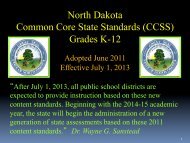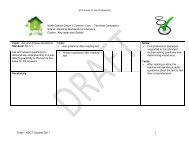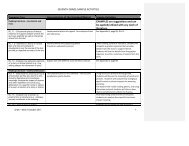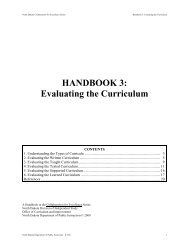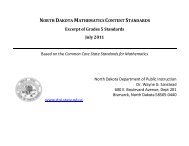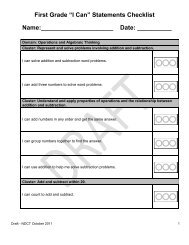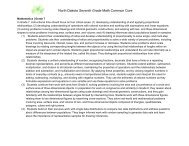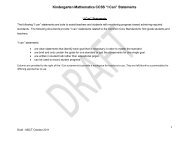North Dakota First Grade Common Core - ND Curriculum Initiative
North Dakota First Grade Common Core - ND Curriculum Initiative
North Dakota First Grade Common Core - ND Curriculum Initiative
Create successful ePaper yourself
Turn your PDF publications into a flip-book with our unique Google optimized e-Paper software.
<strong>North</strong> <strong>Dakota</strong> <strong>First</strong> <strong>Grade</strong> <strong>Common</strong> <strong>Core</strong>!The Next Generation<br />
Strand: Language<br />
Cluster: Vocabulary Acquisition and Use<br />
Topic: Word Meanings<br />
Standard: L.1.4<br />
Determine or clarify the meaning of<br />
unknown and multiple-meaning words and<br />
phrases based on grade 1 reading and<br />
content, choosing flexibly from an array of<br />
strategies.<br />
a) Use sentence-level context as a clue<br />
to the meaning of a word or phrase.<br />
b) Use frequently occurring affixes as a<br />
clue to the meaning of a word.<br />
c) Identify frequently occurring root<br />
words (e.g., look) and their<br />
inflectional forms (e.g., looks,<br />
looked, looking).<br />
I Can:<br />
• Find root words and endings<br />
• Use word clues to figure out what a<br />
word means<br />
• Use the end of words to figure out<br />
what a word means<br />
Notes:<br />
Tasks:<br />
Read a fictional animal story, such as Are You My<br />
Mother? by Philip D. Eastman. Discuss the vocabulary in<br />
the story and work on retelling. Ask the students (if, for<br />
example, discussing Are You My Mother?), “What word<br />
was funny in the story because of the way it was used?”<br />
(Possible answer: “Snort”) How did you know what it<br />
meant? Divide the students into groups of three and have<br />
them tell the story to each other, taking turns as each tells<br />
a part. Let them know that if they are stuck on a part of<br />
the story, you will come and allow them to use the book<br />
to solve the problem. Encourage the students to try to<br />
remember as many details as they can to tell the story<br />
because that is what makes it interesting. When they are<br />
finished retelling the story, talk about what lesson might<br />
be learned from the story.<br />
Source: commoncore.org<br />
Choose some verbs that are rather bland, such as “to<br />
walk.” Ask the children to imagine that they are in the<br />
book The Wizard of Oz by Frank Baum with Dorothy and<br />
that they are walking on the yellow brick road. Have them<br />
imagine that they are really happy. How would they walk?<br />
(Possible answers: Skip, run, dance.) Allow students to<br />
show us how that kind of motion would look. Then, have<br />
them imagine that they are feeling sad and discouraged.<br />
How would they walk? (Possible answers: trudge, drag)<br />
Make a list of all the words that could be used as a better<br />
choice than “walk.”This lesson on verbs can be extended<br />
to cover roots and affixes –ed, -s, -ing.<br />
Source: commoncore.org<br />
Draft - <strong>ND</strong>CT August 2011 42




